League of Legends Exploration
An incredibly popular RTS game, League of Legends is an interesting combination of player mechanics, individual skill and teamwork. Here we investigate a dataset of LoL matches and see whether we can use any of it to predict a winner!
Pre-Processing
import pandas as pd
import numpy as np
import matplotlib.pyplot as plt
import json as json
import seaborn as sns
df = pd.read_csv(r"D:\Downloads\Coding\league-of-legends\games.csv")
champions = pd.read_json(r"D:\Downloads\Coding\league-of-legends\champion_info.json")
spells = pd.read_json(r"D:\Downloads\Coding\league-of-legends\summoner_spell_info.json")
df.head()
| gameId | gameDuration | seasonId | winner | firstBlood | firstTower | firstInhibitor | firstBaron | firstDragon | firstRiftHerald | ... | t2_towerKills | t2_inhibitorKills | t2_baronKills | t2_dragonKills | t2_riftHeraldKills | t2_ban1 | t2_ban2 | t2_ban3 | t2_ban4 | t2_ban5 | |
|---|---|---|---|---|---|---|---|---|---|---|---|---|---|---|---|---|---|---|---|---|---|
| 0 | 3326086514 | 1949 | 9 | 0 | 0 | 1 | 1 | 1 | 1 | 0 | ... | 5 | 0 | 0 | 1 | 1 | 114 | 67 | 43 | 16 | 51 |
| 1 | 3229566029 | 1851 | 9 | 0 | 1 | 1 | 1 | 0 | 1 | 1 | ... | 2 | 0 | 0 | 0 | 0 | 11 | 67 | 238 | 51 | 420 |
| 2 | 3327363504 | 1493 | 9 | 0 | 0 | 1 | 1 | 1 | 0 | 0 | ... | 2 | 0 | 0 | 1 | 0 | 157 | 238 | 121 | 57 | 28 |
| 3 | 3326856598 | 1758 | 9 | 0 | 1 | 1 | 1 | 1 | 1 | 0 | ... | 0 | 0 | 0 | 0 | 0 | 164 | 18 | 141 | 40 | 51 |
| 4 | 3330080762 | 2094 | 9 | 0 | 0 | 1 | 1 | 1 | 1 | 0 | ... | 3 | 0 | 0 | 1 | 0 | 86 | 11 | 201 | 122 | 18 |
5 rows × 60 columns
df.info()
<class 'pandas.core.frame.DataFrame'>
RangeIndex: 51536 entries, 0 to 51535
Data columns (total 60 columns):
gameId 51536 non-null int64
gameDuration 51536 non-null int64
seasonId 51536 non-null int64
winner 51536 non-null int64
firstBlood 51536 non-null int64
firstTower 51536 non-null int64
firstInhibitor 51536 non-null int64
firstBaron 51536 non-null int64
firstDragon 51536 non-null int64
firstRiftHerald 51536 non-null int64
t1_champ1id 51536 non-null int64
t1_champ1_sum1 51536 non-null int64
t1_champ1_sum2 51536 non-null int64
t1_champ2id 51536 non-null int64
t1_champ2_sum1 51536 non-null int64
t1_champ2_sum2 51536 non-null int64
t1_champ3id 51536 non-null int64
t1_champ3_sum1 51536 non-null int64
t1_champ3_sum2 51536 non-null int64
t1_champ4id 51536 non-null int64
t1_champ4_sum1 51536 non-null int64
t1_champ4_sum2 51536 non-null int64
t1_champ5id 51536 non-null int64
t1_champ5_sum1 51536 non-null int64
t1_champ5_sum2 51536 non-null int64
t1_towerKills 51536 non-null int64
t1_inhibitorKills 51536 non-null int64
t1_baronKills 51536 non-null int64
t1_dragonKills 51536 non-null int64
t1_riftHeraldKills 51536 non-null int64
t1_ban1 51536 non-null int64
t1_ban2 51536 non-null int64
t1_ban3 51536 non-null int64
t1_ban4 51536 non-null int64
t1_ban5 51536 non-null int64
t2_champ1id 51536 non-null int64
t2_champ1_sum1 51536 non-null int64
t2_champ1_sum2 51536 non-null int64
t2_champ2id 51536 non-null int64
t2_champ2_sum1 51536 non-null int64
t2_champ2_sum2 51536 non-null int64
t2_champ3id 51536 non-null int64
t2_champ3_sum1 51536 non-null int64
t2_champ3_sum2 51536 non-null int64
t2_champ4id 51536 non-null int64
t2_champ4_sum1 51536 non-null int64
t2_champ4_sum2 51536 non-null int64
t2_champ5id 51536 non-null int64
t2_champ5_sum1 51536 non-null int64
t2_champ5_sum2 51536 non-null int64
t2_towerKills 51536 non-null int64
t2_inhibitorKills 51536 non-null int64
t2_baronKills 51536 non-null int64
t2_dragonKills 51536 non-null int64
t2_riftHeraldKills 51536 non-null int64
t2_ban1 51536 non-null int64
t2_ban2 51536 non-null int64
t2_ban3 51536 non-null int64
t2_ban4 51536 non-null int64
t2_ban5 51536 non-null int64
dtypes: int64(60)
memory usage: 23.6 MB
df.describe()
| gameId | gameDuration | seasonId | winner | firstBlood | firstTower | firstInhibitor | firstBaron | firstDragon | firstRiftHerald | ... | t2_towerKills | t2_inhibitorKills | t2_baronKills | t2_dragonKills | t2_riftHeraldKills | t2_ban1 | t2_ban2 | t2_ban3 | t2_ban4 | t2_ban5 | |
|---|---|---|---|---|---|---|---|---|---|---|---|---|---|---|---|---|---|---|---|---|---|
| count | 5.153600e+04 | 51536.000000 | 51536.0 | 51536.000000 | 51536.000000 | 51536.000000 | 51536.000000 | 51536.000000 | 51536.000000 | 51536.000000 | ... | 51536.000000 | 51536.000000 | 51536.000000 | 51536.000000 | 51536.000000 | 51536.000000 | 51536.000000 | 51536.000000 | 51536.000000 | 51536.000000 |
| mean | 3.306218e+09 | 1832.433658 | 9.0 | 0.493577 | 0.507141 | 0.502134 | 0.447765 | 0.286654 | 0.479471 | 0.251416 | ... | 5.549849 | 0.985078 | 0.414565 | 1.404397 | 0.240220 | 108.203605 | 107.957991 | 108.686666 | 108.636196 | 108.081031 |
| std | 2.946137e+07 | 511.935772 | 0.0 | 0.499964 | 0.499954 | 0.500000 | 0.497269 | 0.452203 | 0.499583 | 0.433832 | ... | 3.860701 | 1.256318 | 0.613800 | 1.224289 | 0.427221 | 102.538299 | 102.938916 | 102.592143 | 103.356702 | 102.762418 |
| min | 3.214824e+09 | 190.000000 | 9.0 | 0.000000 | 0.000000 | 0.000000 | 0.000000 | 0.000000 | 0.000000 | 0.000000 | ... | 0.000000 | 0.000000 | 0.000000 | 0.000000 | 0.000000 | -1.000000 | -1.000000 | -1.000000 | -1.000000 | -1.000000 |
| 25% | 3.292212e+09 | 1531.000000 | 9.0 | 0.000000 | 0.000000 | 0.000000 | 0.000000 | 0.000000 | 0.000000 | 0.000000 | ... | 2.000000 | 0.000000 | 0.000000 | 0.000000 | 0.000000 | 38.000000 | 37.000000 | 38.000000 | 38.000000 | 38.000000 |
| 50% | 3.319969e+09 | 1833.000000 | 9.0 | 0.000000 | 1.000000 | 1.000000 | 0.000000 | 0.000000 | 0.000000 | 0.000000 | ... | 6.000000 | 0.000000 | 0.000000 | 1.000000 | 0.000000 | 90.000000 | 90.000000 | 90.000000 | 90.000000 | 90.000000 |
| 75% | 3.327097e+09 | 2148.000000 | 9.0 | 1.000000 | 1.000000 | 1.000000 | 1.000000 | 1.000000 | 1.000000 | 1.000000 | ... | 9.000000 | 2.000000 | 1.000000 | 2.000000 | 0.000000 | 141.000000 | 141.000000 | 141.000000 | 141.000000 | 141.000000 |
| max | 3.331833e+09 | 4728.000000 | 9.0 | 1.000000 | 1.000000 | 1.000000 | 1.000000 | 1.000000 | 1.000000 | 1.000000 | ... | 11.000000 | 10.000000 | 4.000000 | 6.000000 | 1.000000 | 516.000000 | 516.000000 | 516.000000 | 516.000000 | 516.000000 |
8 rows × 60 columns
EDA
We can perform some basic manipulations to get an insight into the frequency with which differenct champions & summoner spells are selected, as well as the differences in selection between the two teams.
- Most common champion picks
- Most common team picks
- Most common pairs
- Most common spells
- Most common champion + spells
# Convert from an ID to a name
champ_names11 = [champions.ix[y][0]['name'] for y in df.t1_champ1id]
champ_names12 = [champions.ix[y][0]['name'] for y in df.t1_champ2id]
champ_names13 = [champions.ix[y][0]['name'] for y in df.t1_champ3id]
champ_names14 = [champions.ix[y][0]['name'] for y in df.t1_champ4id]
champ_names15 = [champions.ix[y][0]['name'] for y in df.t1_champ5id]
champ_names21 = [champions.ix[y][0]['name'] for y in df.t2_champ1id]
champ_names22 = [champions.ix[y][0]['name'] for y in df.t2_champ2id]
champ_names23 = [champions.ix[y][0]['name'] for y in df.t2_champ3id]
champ_names24 = [champions.ix[y][0]['name'] for y in df.t2_champ4id]
champ_names25 = [champions.ix[y][0]['name'] for y in df.t2_champ5id]
c11 = pd.DataFrame(np.column_stack([champ_names11, np.repeat(1, len(df)), np.repeat(1, len(df))]),
columns=["name", "team", "champ"])
c12 = pd.DataFrame(np.column_stack([champ_names12, np.repeat(1, len(df)), np.repeat(2, len(df))]),
columns=["name", "team", "champ"])
c13 = pd.DataFrame(np.column_stack([champ_names13, np.repeat(1, len(df)), np.repeat(3, len(df))]),
columns=["name", "team", "champ"])
c14 = pd.DataFrame(np.column_stack([champ_names14, np.repeat(1, len(df)), np.repeat(4, len(df))]),
columns=["name", "team", "champ"])
c15 = pd.DataFrame(np.column_stack([champ_names15, np.repeat(1, len(df)), np.repeat(5, len(df))]),
columns=["name", "team", "champ"])
c21 = pd.DataFrame(np.column_stack([champ_names21, np.repeat(2, len(df)), np.repeat(1, len(df))]),
columns=["name", "team", "champ"])
c22 = pd.DataFrame(np.column_stack([champ_names22, np.repeat(2, len(df)), np.repeat(2, len(df))]),
columns=["name", "team", "champ"])
c23 = pd.DataFrame(np.column_stack([champ_names23, np.repeat(2, len(df)), np.repeat(3, len(df))]),
columns=["name", "team", "champ"])
c24 = pd.DataFrame(np.column_stack([champ_names24, np.repeat(2, len(df)), np.repeat(4, len(df))]),
columns=["name", "team", "champ"])
c25 = pd.DataFrame(np.column_stack([champ_names25, np.repeat(2, len(df)), np.repeat(5, len(df))]),
columns=["name", "team", "champ"])
comb_names = pd.DataFrame(np.vstack([c11, c12, c13, c14, c15, c21, c22, c23, c24, c25]),
columns=["name", "team", "champ"])
# Convert from an ID to a name
spells_names111 = [spells.ix[y][0]['name'] for y in df.t1_champ1_sum1]
spells_names112 = [spells.ix[y][0]['name'] for y in df.t1_champ1_sum2]
spells_names121 = [spells.ix[y][0]['name'] for y in df.t1_champ2_sum1]
spells_names122 = [spells.ix[y][0]['name'] for y in df.t1_champ2_sum2]
spells_names131 = [spells.ix[y][0]['name'] for y in df.t1_champ3_sum1]
spells_names132 = [spells.ix[y][0]['name'] for y in df.t1_champ3_sum2]
spells_names141 = [spells.ix[y][0]['name'] for y in df.t1_champ4_sum1]
spells_names142 = [spells.ix[y][0]['name'] for y in df.t1_champ4_sum2]
spells_names151 = [spells.ix[y][0]['name'] for y in df.t1_champ5_sum1]
spells_names152 = [spells.ix[y][0]['name'] for y in df.t1_champ5_sum2]
spells_names211 = [spells.ix[y][0]['name'] for y in df.t2_champ1_sum1]
spells_names212 = [spells.ix[y][0]['name'] for y in df.t2_champ1_sum2]
spells_names221 = [spells.ix[y][0]['name'] for y in df.t2_champ2_sum1]
spells_names222 = [spells.ix[y][0]['name'] for y in df.t2_champ2_sum2]
spells_names231 = [spells.ix[y][0]['name'] for y in df.t2_champ3_sum1]
spells_names232 = [spells.ix[y][0]['name'] for y in df.t2_champ3_sum2]
spells_names241 = [spells.ix[y][0]['name'] for y in df.t2_champ4_sum1]
spells_names242 = [spells.ix[y][0]['name'] for y in df.t2_champ4_sum2]
spells_names251 = [spells.ix[y][0]['name'] for y in df.t2_champ5_sum1]
spells_names252 = [spells.ix[y][0]['name'] for y in df.t2_champ5_sum2]
t1s1 = pd.DataFrame(np.column_stack([spells_names111, spells_names112, np.repeat(1, len(df)), np.repeat(1, len(df))]),
columns=["sum1", "sum2", "team", "champ"])
t1s2 = pd.DataFrame(np.column_stack([spells_names121, spells_names122, np.repeat(1, len(df)), np.repeat(2, len(df))]),
columns=["sum1", "sum2", "team", "champ"])
t1s3 = pd.DataFrame(np.column_stack([spells_names131, spells_names132, np.repeat(1, len(df)), np.repeat(3, len(df))]),
columns=["sum1", "sum2", "team", "champ"])
t1s4 = pd.DataFrame(np.column_stack([spells_names141, spells_names142, np.repeat(1, len(df)), np.repeat(4, len(df))]),
columns=["sum1", "sum2", "team", "champ"])
t1s5 = pd.DataFrame(np.column_stack([spells_names151, spells_names152, np.repeat(1, len(df)), np.repeat(5, len(df))]),
columns=["sum1", "sum2", "team", "champ"])
t2s1 = pd.DataFrame(np.column_stack([spells_names211, spells_names212, np.repeat(2, len(df)), np.repeat(1, len(df))]),
columns=["sum1", "sum2", "team", "champ"])
t2s2 = pd.DataFrame(np.column_stack([spells_names221, spells_names222, np.repeat(2, len(df)), np.repeat(2, len(df))]),
columns=["sum1", "sum2", "team", "champ"])
t2s3 = pd.DataFrame(np.column_stack([spells_names231, spells_names232, np.repeat(2, len(df)), np.repeat(3, len(df))]),
columns=["sum1", "sum2", "team", "champ"])
t2s4 = pd.DataFrame(np.column_stack([spells_names241, spells_names242, np.repeat(2, len(df)), np.repeat(4, len(df))]),
columns=["sum1", "sum2", "team", "champ"])
t2s5 = pd.DataFrame(np.column_stack([spells_names251, spells_names252, np.repeat(2, len(df)), np.repeat(5, len(df))]),
columns=["sum1", "sum2", "team", "champ"])
comb_spells = pd.DataFrame(np.vstack([t1s1, t1s2, t1s3, t1s4, t1s5,
t2s1, t2s2, t2s3, t2s4, t2s5]),
columns=["sum1", "sum2", "team", "champ"])
# Aggregate all info into a single dataframe
all_names = pd.merge(comb_names, comb_spells, left_index=True, right_index=True)
all_names = all_names.drop(["team_y", "champ_y"], axis=1)
Champion Selections
Here we map out both the difference in selections between the two teams, as well as the total frequency of champion selection.
Interestingly we see that Janna and Xayah have the most dispairty between the two teams. Perhaps they are both good counters to each other and so if one team sees the other being chosen, the opposing team counters. In the middle of the pack with little to no difference we see picks such as Lucian, LeBlanc, Karma, Soraka and Yasuo.
plt.figure(figsize=(15,10))
test = all_names.groupby(["name", "team_x"])["champ_x"].count()
test = test.unstack()
test["diff"] = test.ix[:, 0] - test.ix[:, 1]
test["diff"].sort_values(ascending=False).plot(kind="bar")
plt.show()
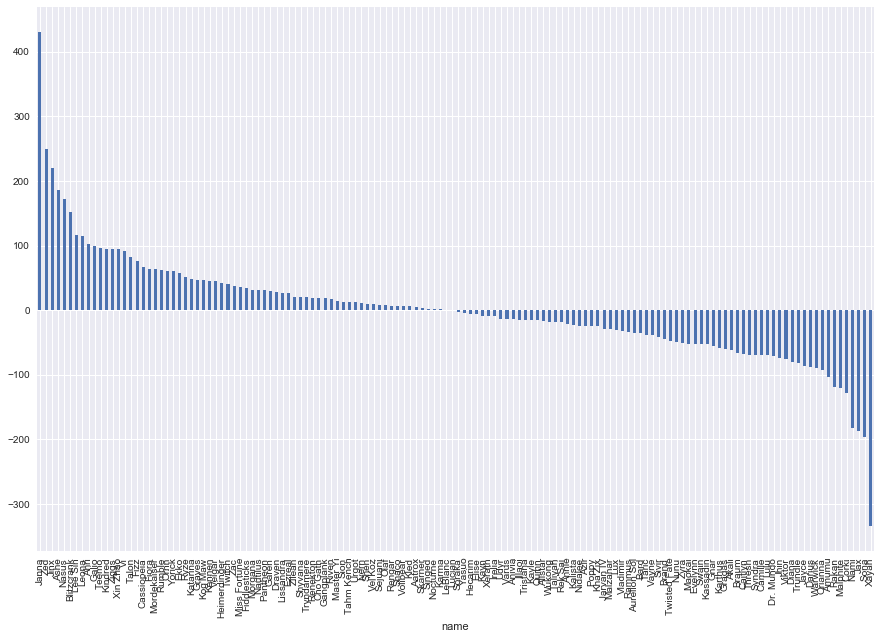
In terms of total frequency, we see Thresh and Tristana fighting it out for first place, with them being followed up by Vayne, Kayn and Lee Sin. No surprises here given the popularity of these champions.
plt.figure(figsize=(20,10))
all_names.groupby(["name"])["name"].count().sort_values(ascending=False).plot(kind="bar")
plt.ylabel("Frequency")
plt.xlabel("Champion Name")
plt.title("Frequency of Champion Selection")
plt.show()

Summoner Spells
We conduct a similar process as above, and exmaine the most frequently used summoner spells and pairings with champions. Not unsurprisingly Flash tops the list in both cases. It looks like Ghost, Barrier and Cleanse are seen as the worst performing spells and rarely picked.
all_names.groupby(["sum1"])["sum1"].count().sort_values(ascending=False).plot(kind="bar")
plt.xlabel("Spell 1")
plt.ylabel("Frequency")
plt.show()
all_names.groupby(["sum2"])["sum2"].count().sort_values(ascending=False).plot(kind="bar")
plt.xlabel("Spell 2")
plt.ylabel("Frequency")
plt.show()

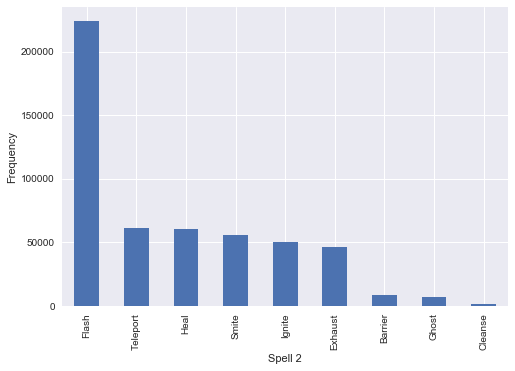
sum1_diff = all_names.groupby(["sum1", "team_x"])["sum1"].count().unstack()
sum1_diff["diff"] = sum1_diff.ix[:,0] - sum1_diff.ix[:,1]
sum1_diff["diff"].plot(kind="bar")
plt.ylabel("Difference Between Team 1 and Team 2")
plt.xlabel("Spell 1")
plt.show()
sum2_diff = all_names.groupby(["sum2", "team_x"])["sum2"].count().unstack()
sum2_diff["diff"] = sum2_diff.ix[:,0] - sum2_diff.ix[:,1]
sum2_diff["diff"].plot(kind="bar")
plt.ylabel("Difference Between Team 1 and Team 2")
plt.xlabel("Spell 2")
plt.show()
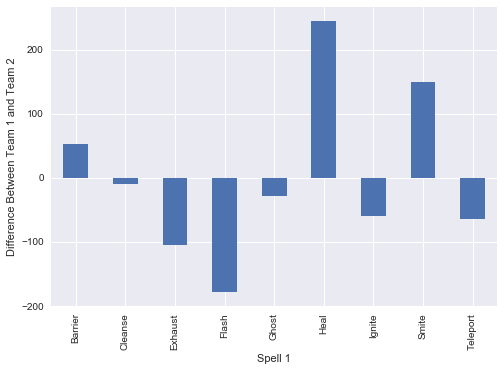
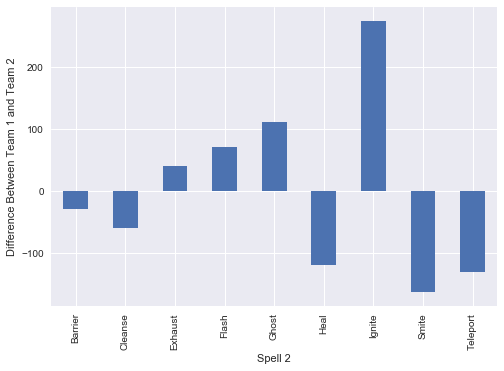
An interesting question is what are the most common spell selections for each champion. We expect that there would be considerable variation in spell selections, depending on both individual playstyle as well as the category that the champion falls into. To do this, we can simply aggregate up all the champions & spells, and then normalise across each champion to get the ratios that each one selects.
Some points of interest:
- Average ratio of flash is ~55-60%
- Hecarim has a substantially lower ratio of flash, given his special which allows him to escape quickly
- Olaf also has a substantially lower ratio of flash
- Also appears to be a fairly consistent ratio of the second preferred spell across most champions
champ_spell_comb = all_names.groupby(["name", "sum1"])["name"].count().unstack().fillna(0)
champ_spell_comb = champ_spell_comb.div(champ_spell_comb.sum(axis=1), axis=0) # normalising
champ_spell_comb.ix[0:20, :].plot(kind="bar", figsize=(15,10))
plt.ylabel("Fraction of Selections")
plt.legend(loc='center right', bbox_to_anchor=(1.15, 0.5))
plt.show()
champ_spell_comb.ix[21:40, :].plot(kind="bar", figsize=(15,10))
plt.ylabel("Fraction of Selections")
plt.legend(loc='center right', bbox_to_anchor=(1.15, 0.5))
plt.show()
champ_spell_comb.ix[41:60, :].plot(kind="bar", figsize=(15,10))
plt.ylabel("Fraction of Selections")
plt.legend(loc='center right', bbox_to_anchor=(1.15, 0.5))
plt.show()
champ_spell_comb.ix[61:80, :].plot(kind="bar", figsize=(15,10))
plt.ylabel("Fraction of Selections")
plt.legend(loc='center right', bbox_to_anchor=(1.15, 0.5))
plt.show()
champ_spell_comb.ix[81:100, :].plot(kind="bar", figsize=(15,10))
plt.ylabel("Fraction of Selections")
plt.legend(loc='center right', bbox_to_anchor=(1.15, 0.5))
plt.show()
champ_spell_comb.ix[101:128, :].plot(kind="bar", figsize=(15,10))
plt.ylabel("Fraction of Selections")
plt.legend(loc='center right', bbox_to_anchor=(1.15, 0.5))
plt.show()
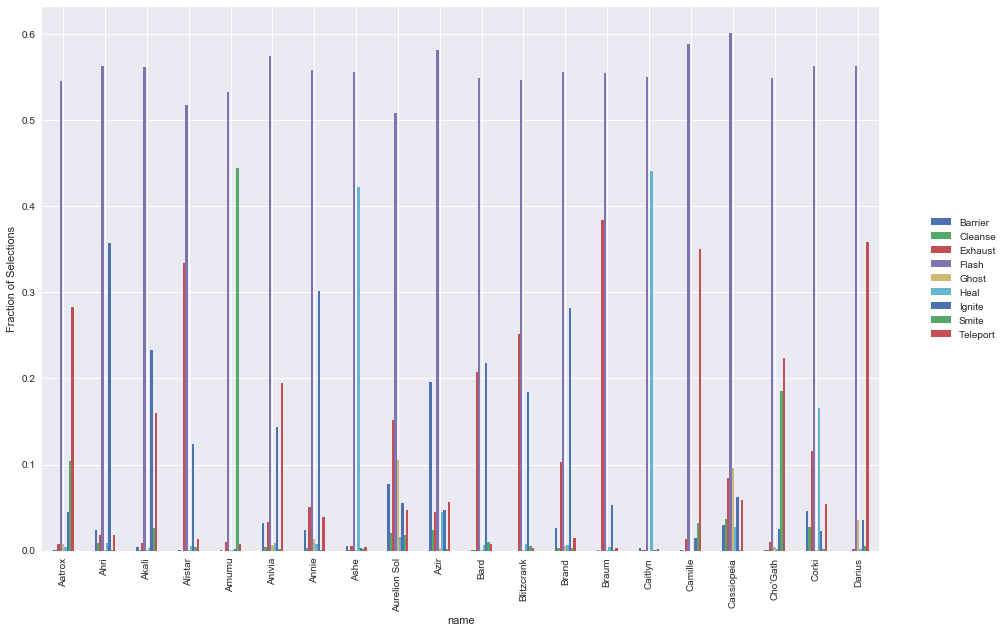
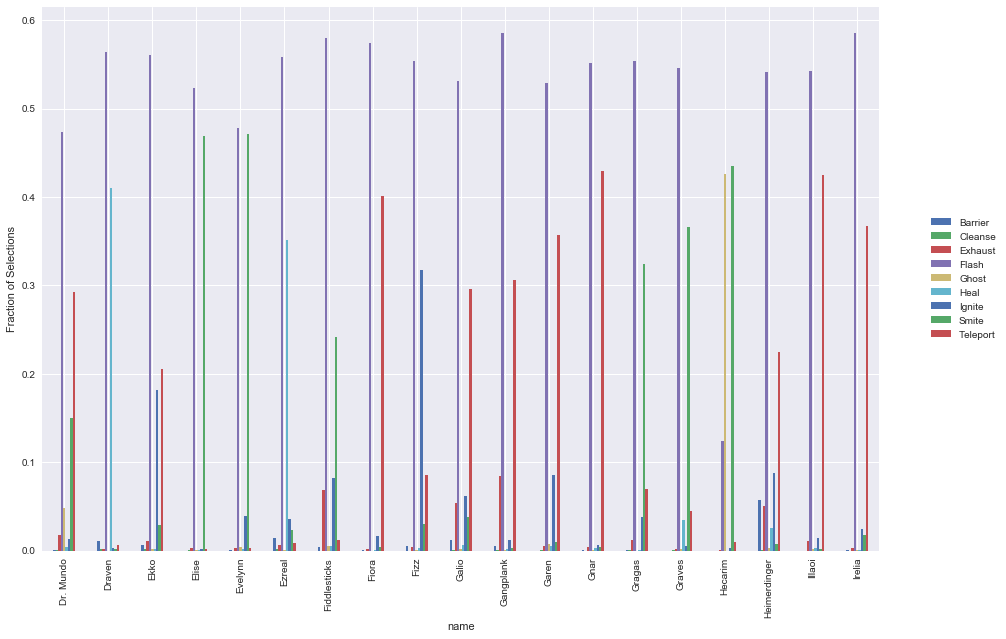
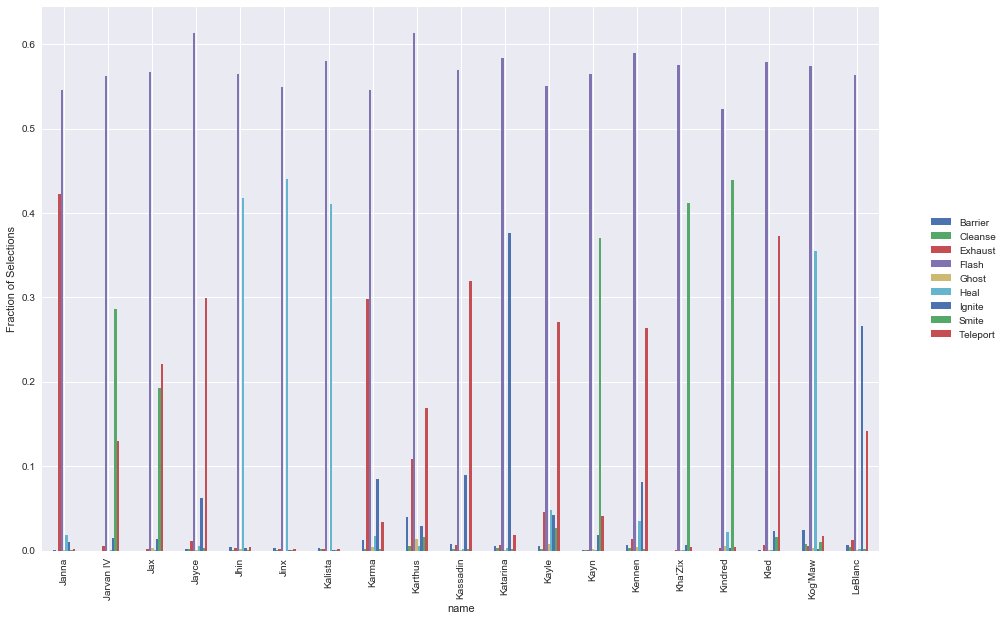
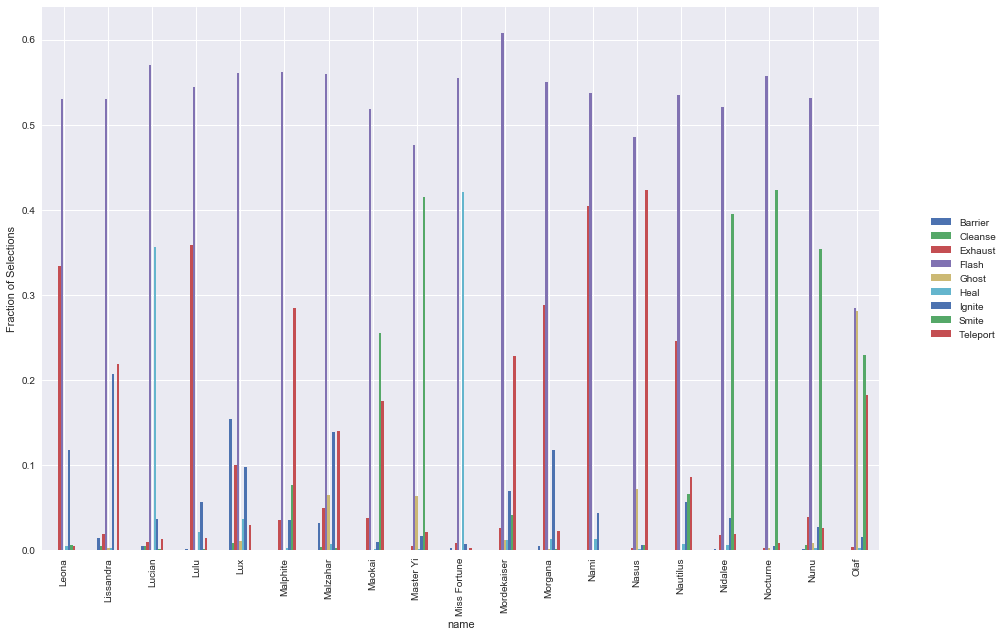
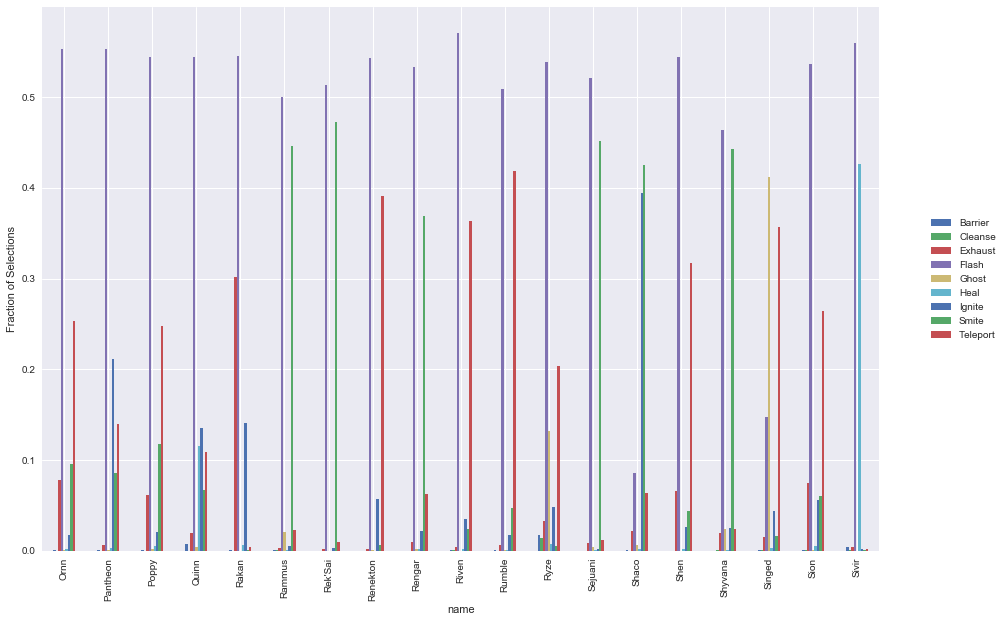
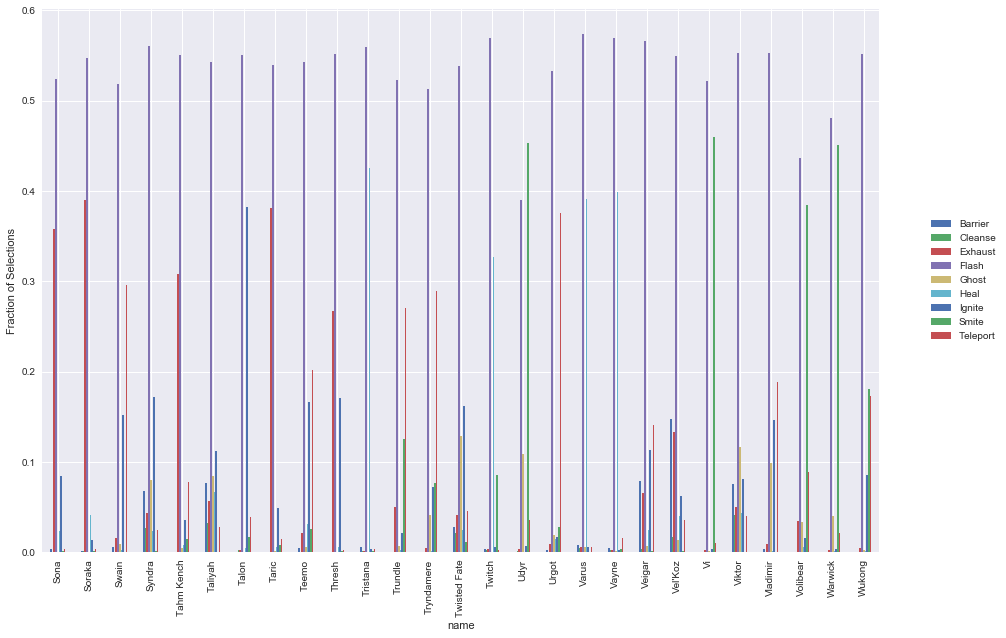
Predictive Analysis
Now that we’ve pulled apart the data, what’s more interesting is seeing whether we can use it to predict the winner of a game.
From the heatmap below, we see that there are very obvious clusters of correlated variables:
- First game objectives
- Total number of objective kills
These are not unsurprising as a team who is doing good/bad will likely of opposing levels of objectives/kills.
corrmat = df.corr()
plt.figure(figsize = (15,10))
sns.heatmap(corrmat, square=True)
plt.show()

cols = ['winner','t1_towerKills', 't1_inhibitorKills', 't1_baronKills', 't2_towerKills', 't2_inhibitorKills', 't2_baronKills',]
sns.pairplot(df[cols])
plt.show()
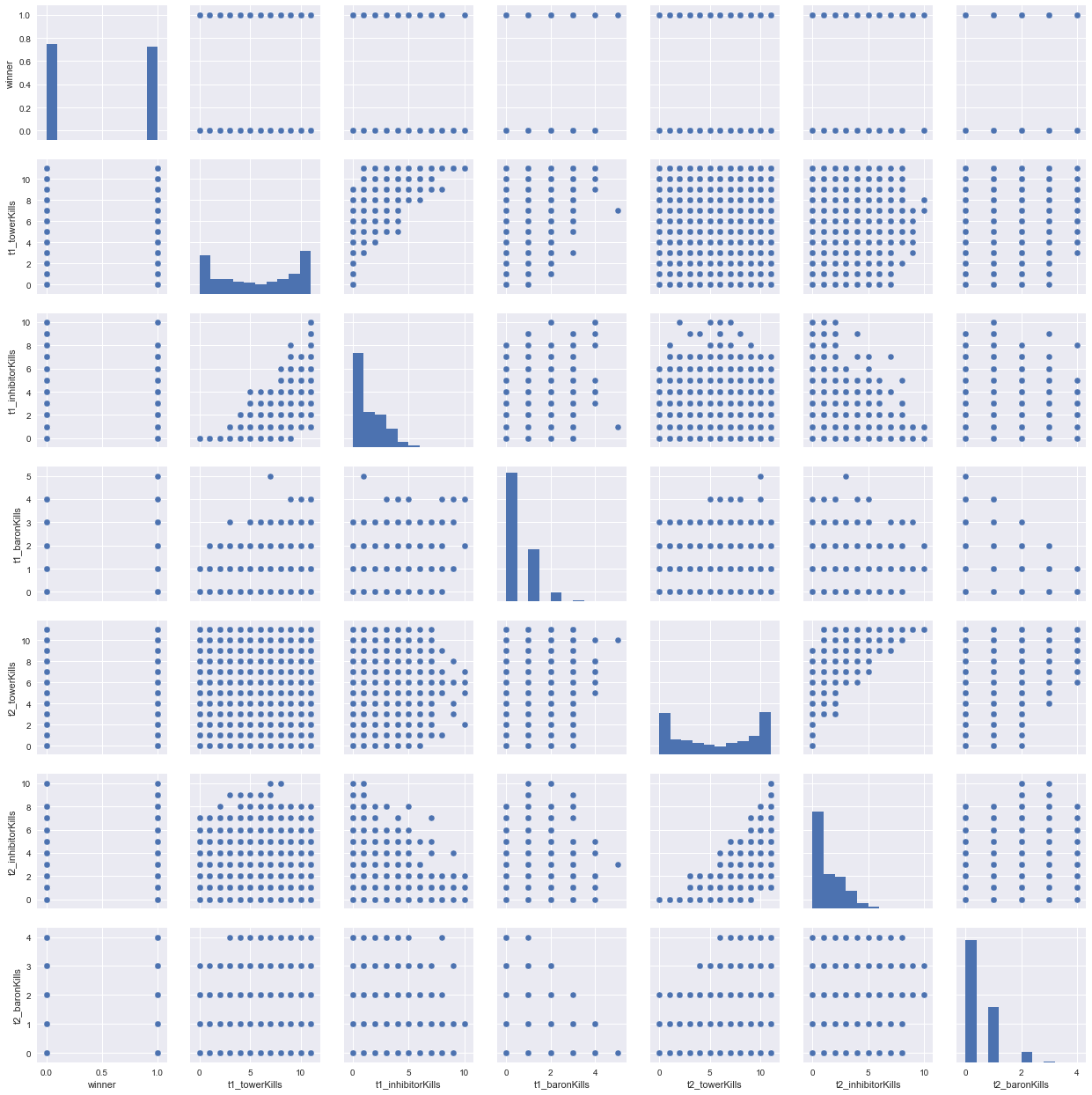
Structural Analysis
We can do some basic PCA and K-Means clustering to see if there is any obvious structure which exists in our dataset. We should also be clear that we are working with the dataset that does include endgame statistics… i.e. we should expect fairly high predictive strength. We will investigate later a prediction using variables only known at the start of a match.
import plotly.offline as py
py.init_notebook_mode(connected=True)
import plotly.graph_objs as go
import plotly.tools as tls
from sklearn.decomposition import PCA
from sklearn.preprocessing import StandardScaler
X = df.drop(['gameId', 'seasonId', 'winner'], 1)
y = df['winner']
X_std = StandardScaler().fit_transform(X)
n_components = 5
X_std = X_std[:2000]
pca = PCA(n_components=n_components).fit(X_std)
Target = y[:2000]
X_5d = pca.transform(X_std)
trace0 = go.Scatter(
x = X_5d[:,0],
y = X_5d[:,1],
name = Target,
hoveron = Target,
mode = 'markers',
text = Target,
showlegend = False,
marker = dict(
size = 8,
color = Target,
colorscale ='Jet',
showscale = False,
line = dict(
width = 2,
color = 'rgb(255, 255, 255)'
),
opacity = 0.8
)
)
data = [trace0]
layout = go.Layout(
title= 'Principal Component Analysis (PCA)',
hovermode= 'closest',
xaxis= dict(
title= 'First Principal Component',
ticklen= 5,
zeroline= False,
gridwidth= 2,
),
yaxis=dict(
title= 'Second Principal Component',
ticklen= 5,
gridwidth= 2,
),
showlegend= True
)
fig = dict(data=data, layout=layout)
py.iplot(fig, filename='styled-scatter')
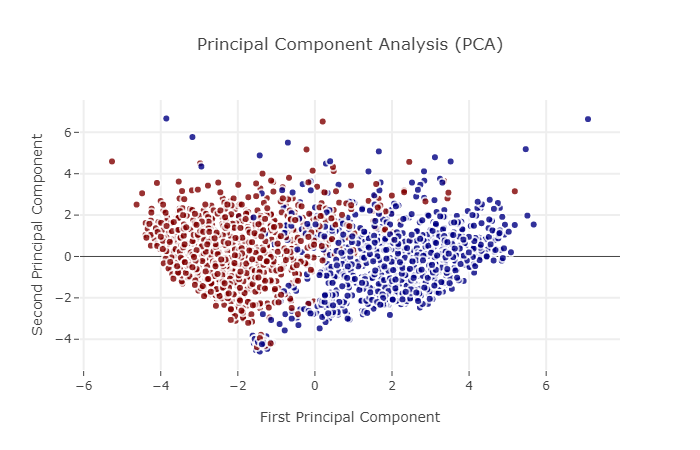
from sklearn.cluster import KMeans # KMeans clustering
kmeans = KMeans(n_clusters=2)
X_clustered = kmeans.fit_predict(X_5d)
trace_Kmeans = go.Scatter(x=X_5d[:, 0], y= X_5d[:, 1], mode="markers",
showlegend=False,
marker=dict(
size=8,
color = X_clustered,
colorscale = 'Portland',
showscale=False,
line = dict(
width = 2,
color = 'rgb(255, 255, 255)'
)
))
layout = go.Layout(
title= 'KMeans Clustering',
hovermode= 'closest',
xaxis= dict(
title= 'First Principal Component',
ticklen= 5,
zeroline= False,
gridwidth= 2,
),
yaxis=dict(
title= 'Second Principal Component',
ticklen= 5,
gridwidth= 2,
),
showlegend= True
)
data = [trace_Kmeans]
fig1 = dict(data=data, layout= layout)
# fig1.append_trace(contour_list)
py.iplot(fig1, filename="svm")

from sklearn.manifold import TSNE
tsne = TSNE()
tsne_results = tsne.fit_transform(X_std)
traceTSNE = go.Scatter(
x = tsne_results[:,0],
y = tsne_results[:,1],
name = Target,
hoveron = Target,
mode = 'markers',
text = Target,
showlegend = True,
marker = dict(
size = 8,
color = Target,
colorscale ='Jet',
showscale = False,
line = dict(
width = 2,
color = 'rgb(255, 255, 255)'
),
opacity = 0.8
)
)
data = [traceTSNE]
layout = dict(title = 'TSNE (T-Distributed Stochastic Neighbour Embedding)',
hovermode= 'closest',
yaxis = dict(zeroline = False),
xaxis = dict(zeroline = False),
showlegend= False,
)
fig = dict(data=data, layout=layout)
py.iplot(fig, filename='styled-scatter')

The above three techniques demonstrate that there is a pretty clear structural differentiation between winning and losing. This bodes well for running some machine learning techniques across the dataset.
As seen below, the scores we get are all in excess of 90%. This is not unexpected given the level of data which is available and the fact that it is end game data.
#Preprocessing
from sklearn.model_selection import train_test_split
from sklearn.preprocessing import StandardScaler
#Algos
from sklearn.linear_model import LogisticRegression
from sklearn.neighbors import KNeighborsClassifier
from sklearn.svm import SVC
from xgboost import XGBClassifier
#Postprocessing
from sklearn.feature_selection import SelectFromModel
from sklearn.metrics import accuracy_score
from xgboost import plot_importance
X_std = StandardScaler().fit_transform(X)
X_train, X_test, y_train, y_test = train_test_split(X_std, y)
clf = LogisticRegression()
clf.fit(X_train, y_train)
clf2 = SVC(kernel="linear", C=0.025)
clf2.fit(X_train, y_train)
clf3 = XGBClassifier()
clf3.fit(X_train, y_train)
cl4 = KNeighborsClassifier()
cl4.fit(X_train, y_train)
print("Logistic Regr. Score = ", clf.score(X_test, y_test))
print("SVC Linear Kernel Score = ", clf2.score(X_test, y_test))
print("XGBoost Score = ", clf3.score(X_test, y_test))
print("KNN Score = ", cl4.score(X_test, y_test))
Logistic Regr. Score = 0.961192176343
SVC Linear Kernel Score = 0.96010555728
XGBoost Score = 0.96763427507
KNN Score = 0.924712822105
Feature Importance
The basic question to answer is… what is driving these high scores? What features in our dataset are allowing such high predictions?
The answer is … tower kills and inhibitor kills. Not unsurprisingly, the team which destroys the most towers and most inhibitors wins. Given that this is the prime objective of the game, this is not unexpected.
plt.bar(range(len(clf3.feature_importances_)), clf3.feature_importances_)
plt.xlabel("Feature")
plt.ylabel("Relative Importance")
plt.show()
plot_importance(clf3)
plt.show()
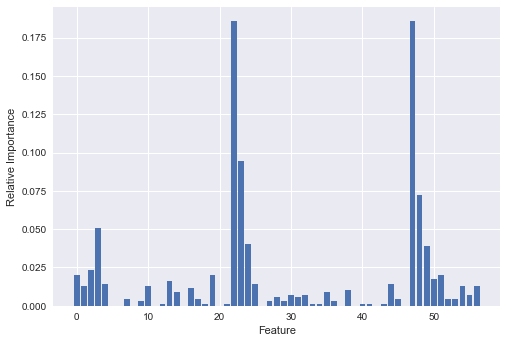
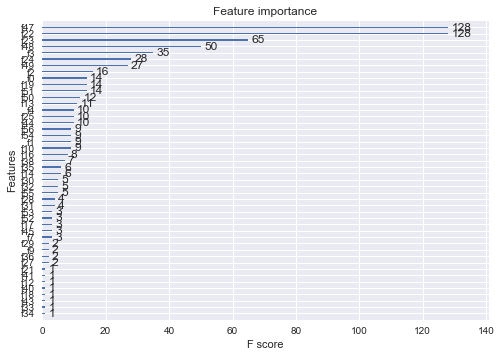
selection = SelectFromModel(clf3, threshold=0.05, prefit=True)
X_train_sel = selection.transform(X_train)
selection_model = XGBClassifier()
selection_model.fit(select_X_train, y_train)
X_test_sel = selection.transform(X_test)
y_pred = selection_model.predict(X_test_sel)
predictions = [round(value) for value in y_pred]
accuracy = accuracy_score(y_test, predictions)
print("Thresh=%.3f, n=%d, Accuracy: %.2f%%" % (0.05, X_train_sel.shape[1], accuracy*100.0))
Thresh=0.050, n=4, Accuracy: 96.05%
X_new = pd.DataFrame(X.columns)
X_new['importance'] = clf3.feature_importances_
X_new.sort_values(by='importance', ascending=False).head(15)
| 0 | importance | |
|---|---|---|
| 47 | t2_towerKills | 0.195015 |
| 22 | t1_towerKills | 0.190616 |
| 23 | t1_inhibitorKills | 0.107038 |
| 48 | t2_inhibitorKills | 0.068915 |
| 3 | firstInhibitor | 0.049853 |
| 24 | t1_baronKills | 0.033724 |
| 49 | t2_baronKills | 0.027859 |
| 13 | t1_champ3id | 0.021994 |
| 16 | t1_champ4id | 0.020528 |
| 19 | t1_champ5id | 0.020528 |
| 50 | t2_dragonKills | 0.017595 |
| 2 | firstTower | 0.017595 |
| 51 | t2_riftHeraldKills | 0.016129 |
| 0 | gameDuration | 0.016129 |
| 54 | t2_ban3 | 0.014663 |
Starting Variables
As stated above, the previous analysis was done on variables which are known at the end of the game. We would expect potentially no predictability given the starting variables. As seen below, this is the case. If we only take variables that are known at the start such as selected champions, summonr spells & team bans, the predictability drops to no better than a coin flip.
This highlights, perhaps, why these RTS games are so popular… no matter what combination of starting variables, the outcome is still highly dependent on individual player skill and how the team comes together. The actual starting selections bare only a marginal impact on the end results.
X_reduced = df.iloc[:, np.r_[10:24, 30:49, 55:59]]
X_reduced = StandardScaler().fit_transform(X_reduced)
X_train, X_test, y_train, y_test = train_test_split(X_reduced, y)
clf = LogisticRegression()
clf.fit(X_train, y_train)
clf3 = XGBClassifier()
clf3.fit(X_train, y_train)
print("Logistic Regr. Score = ", clf.score(X_test, y_test))
print("XGBoost Score = ", clf3.score(X_test, y_test))
Logistic Regr. Score = 0.515135051226
XGBoost Score = 0.519403911829